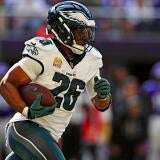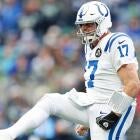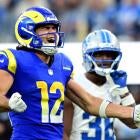
2023 Super Bowl: How GM Howie Roseman's faith in Jalen Hurts helped Eagles build championship-caliber team
A series of aggressive moves by the Eagles GM supplemented Philadelphia's roster

The Philadelphia Eagles finished last season with a respectable 9-8 record and a second place finish in the NFC East. While most analysts spent the offseason questioning Jalen Hurts' merit as an NFL starting quarterback, general manager Howie Roseman doubled down on the third-year player out of Oklahoma. As a result, the franchise is back in the Super Bowl for the first time since winning it all in 2017.
How did they build such a Super Bowl caliber roster?
The hype train was off and running on April 28 when wide receiver A.J. Brown was acquired from Tennessee. The Eagles also drafted defensive tackle Jordan Davis that night with the No. 13 overall selection. The Brown trade was made possible by moves made a year earlier. On draft night, Roseman was armed with three first-round picks. In 2021, the Eagles had traded back from No. 12 overall so that Miami could trade up to No. 6 overall and select wide receiver Jaylen Waddle. Indianapolis also supplied them with a first-round pick as part of the Carson Wentz trade. The wealth of draft resources allowed Roseman to capitalize on an opportunity.
Later in the offseason, Philadelphia signed veteran free agent edge rusher Haason Reddick and cornerback James Bradberry before facilitating a preseason trade for Saints safety C.J. Gardner-Johnson. Roseman was able to make those moves largely due to Hurts' roughly $4.9 million salary cap hit, a little more than 1/10th of his peer on the sideline opposite him in the Super Bowl.
Head coach Nick Sirianni's squad got off to a hot start with an 8-0 record. However, as the season progressed, injuries created needs on the roster. The team responded by signing defensive tackles Linval Joseph and Ndamukong Suh, punter Brett Kern and trading for edge rusher Robert Quinn.
There is a lot of homegrown talent on the roster like wide receiver Devonta Smith, tight end Dallas Goedert, center Jason Kelce, offensive tackles Jordan Mailata and Lane Johnson, defensive tackle Fletcher Cox, edge rusher Josh Sweat and more.
As one studies Philadelphia's roster, an investment in the trenches becomes evident; a calling card of Roseman's tenure in the City of Brotherly Love.
Philadelphia spends the fourth-most salary cap space on the offensive line in the league; roughly 25.65% of the total salary cap. Kansas City's defensive line is a strength but the Eagles should be well-prepared as the five starters along the offensive line have a combined 36 years of experience.
The team also spends the ninth-most salary cap space on the defensive line; roughly 19.38%. The secondary is the only other position group that ranks in the top half of the league (12th) in terms of spending.
The average age of players on the roster is 25.8 years. They have ten players over 30-years old, in addition to rostering eight rookies.
A 14-3 regular season record, as well as a Divisional Round victory over the Giants and a conference championship against San Francisco was the fruits of Roseman's labor.
The best chance to win a Super Bowl is this year and next while Hurts is playing out his rookie contract. It is not to say that the team could not win a Super Bowl without Hurts on a rookie contract -- Patrick Mahomes has a chance to do just that with Kansas City -- but it does become more difficult. The difference between their respective salary cap hits is roughly $42 million; the equivalent of defensive tackle Javon Hargrave, Brown, Kelce and Reddick with some change leftover.
It would not be a surprise if the Eagles were to negotiate an extension with Hurts this offseason. That will be one of many decisions awaiting the franchise as prominent names, such as Brandon Graham, Robert Quinn, Cox, Kelce, Gardner-Johnson and Bradberry litter the list of impending free agents.
Philadelphia is not worried about that yet, however, because they have some business of their own to take care of Feb. 12.


















